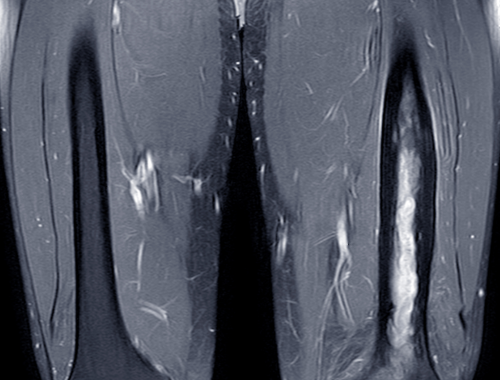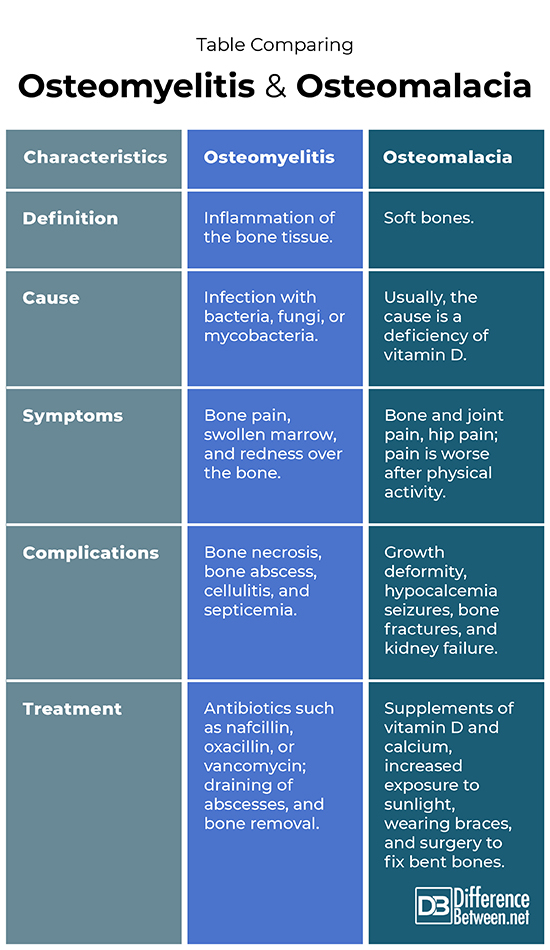Difference Between Osteomyelitis and Osteomalacia
Osteomyelitis is when there is an inflammatory reaction of bone. Osteomalacia is when the bone becomes too soft.

What is Osteomyelitis?
Definition:
This is an inflammation of the bone tissue due to some pathogenic organism.
Causes:
The cause of osteomyelitis is often bacterial, but other pathogens, such as mycobacteria and fungi, can also invade the tissue, causing bone infection and inflammation. Bacteria implicated in osteomyelitis include Klebsiella pneumoniae, Staphylococcus epidermidis, and Staphylococcus aureus. Pathogens can be introduced into the body through injuries or else an infection can spread from another organ.
Symptoms and complications:
Symptoms of osteomyelitis include bone pain. This is caused by swelling of the marrow in response to infection. Swelling and redness are common over the area of bone that is affected. The person may also have a fever and feel very tired.
Diagnosis:
Blood tests and imaging tests can help in the diagnosis of osteomyelitis. Blood test results looking at levels of C-reactive protein and erythrocyte sedimentation rates are helpful. Higher than usual levels of these indicate inflammation. X-rays may show the presence of swelling and may show that the bone tissue is being destroyed. Cultures of bone tissue can show the presence of bacteria or other pathogens.
Treatment:
Treatment includes using antibiotics to kill and inhibit the growth of bacteria. In severe cases, surgical removal of necrotic bone may become necessary. Antibiotics that are used vary depending on the type of osteomyelitis and may include nafcillin, oxacillin, or vancomycin.

What is Osteomalacia?
Definition:
This is the condition when bones become soft.
Causes:
The most common reason for developing osteomalacia is vitamin D deficiency. However, certain tumors can also lead to the condition.
Symptoms and complications:
Symptoms of osteomalacia include hip pain, bone pain, and joint pain. Bones and joints usually hurt more after a person with the condition exercises. Fractures can also occur, particularly in the hips or lumbar region. The foot bones may also break. Walking becomes difficult and the person may have a change in their walking gait, appearing to “waddle”.
Diagnosis:
The diagnosis of osteomalacia is based on a couple of tests. Blood tests can be done. The results will show low vitamin D levels if osteomalacia is present. X-rays and bone density scans can show bones looking less dense. A bone biopsy can indicate that the bone tissue is soft.
Treatment:
A person may have to wear braces to help straighten any deformed limbs. In some instances, surgery may be needed to correct bones. Supplements of calcium and vitamin D, as well as increased sunlight exposure are also recommended as treatments for osteomalacia. Certain medications, like Burosumab, may help with bone mineralization.
Difference between Osteomyelitis and Osteomalacia
Definition
Osteomyelitis is defined as inflammation of the bone tissue. Osteomalacia is defined as soft bones.
Cause
Osteomyelitis is an infection of the bone caused by bacteria, fungi, or mycobacteria. Osteomalacia is caused by a lack of vitamin D.
Symptoms
The symptoms of osteomyelitis are as follows: bone pain, swollen marrow, and redness over the bone. The symptoms of osteomalacia are as follows: bone and joint pain and hip pain; pain is worse after exercise.
Complications
Potential complications of osteomyelitis include bone ulcers, bone necrosis, septicemia, and cellulitis. Potential complications of osteomalacia include growth deformity, hypocalcemia seizures, bone fractures, and kidney failure.
Treatment
Treatment of osteomyelitis is by antibiotics such as nafcillin, oxacillin, or vancomycin; draining of abscesses, and bone removal. Treatment of osteomalacia is by supplements of vitamin D and calcium, increased exposure to sunlight, wearing of braces, and surgery to fix bent bones.
Table comparing Osteomyelitis and Osteomalacia

Summary of Osteomyelitis Vs. Osteomalacia
- Osteomyelitis and osteomalacia are both conditions that affect bone tissue.
- Osteomyelitis is because of pathogens invading the bone.
- Osteomalacia is when bones soften, most often because of vitamin D deficiency.
- Both osteomyelitis and osteomalacia are conditions that need to be treated rapidly to avoid complications.
FAQ
What are the two types of osteomyelitis?
The two types of osteomyelitis are acute and chronic. Chronic infections remain for several weeks, while acute infections occur quickly and go away rapidly with treatment.
What is the meaning of osteomyelitis?
Osteomyelitis means inflammation of the bone, specifically the osseous medulla.
What is the difference between osteitis and osteomyelitis?
In the case of osteitis, infection comes from outside the body (e.g., trauma), while in osteomyelitis, the infection has spread from somewhere else in the body.
What can be mistaken for osteomyelitis?
Neuropathic arthropathy is another condition that can affect the bone marrow and makes it look like osteomyelitis.
What bone is the most common site of osteomyelitis?
The hip bones and vertebrae are the most common site of osteomyelitis.
What is the most accurate test for osteomyelitis?
A bone biopsy and culture of the tissue is the best way to diagnose osteomyelitis.
How often is osteomyelitis misdiagnosed?
Osteomyelitis is incorrectly diagnosed in about 33% of cases.
How can you tell if someone has osteomyelitis?
The bone pain and fever may indicate a person has osteomyelitis but the only way to tell for certain is to see a doctor and have tests to diagnose the condition.
- Difference Between Rumination and Regurgitation - June 13, 2024
- Difference Between Pyelectasis and Hydronephrosis - June 4, 2024
- Difference Between Cellulitis and Erysipelas - June 1, 2024
Search DifferenceBetween.net :
Leave a Response
References :
[0]Oe, Yuki, et al. "Favorable effects of burosumab on tumor-induced osteomalacia caused by an undetectable tumor: a case report." Medicine 100.46 (2021).
[1]Prokesch, Bonnie C., et al. "Primary osteomyelitis caused by hypervirulent Klebsiella pneumoniae." The Lancet Infectious Diseases 16.9 (2016): e190-e195.
[2]Schmitt, Steven. “Osteomyelitis”. Merckmanuals. Merck & Co., 2022, https://www.msdmanuals.com/professional/musculoskeletal-and-connective-tissue-disorders/infections-of-joints-and-bones/osteomyelitis
